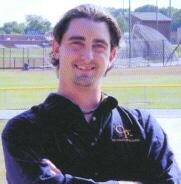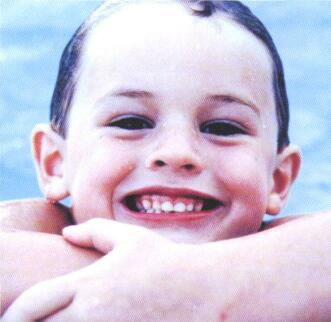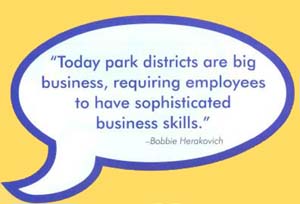|

Simple neighborhood playground fun in the '70s. Photo by Ted FIickinger.
24 Illinois Parks arid Recreation


A young professional's take on the
changing face of parks and recreation

|
|
I look at the face of a young professional who is searching for the vision that will carry the field, the extra effort necessary to find resources to support programs and, of course, the hungry smile.
|
I was out "recreating" after a co—rec softball game last summer with compatriots in the parks and recreation field, when a lively discussion broke
out about the future
and the changing face
of public recreation.
As a person who
likes to visualize what
people say literally, I
drew a picture in my
mind of the face of
recreation as I used to
see it when I first
started full-time, four
years ago. That face
was determined and
interested in seeking
the marrow of every program, every
feedback from participants and, of
course, the quizzical look that often
dances across the face of some young professionals when that alien term
"budget" rears its ugly head.
I imagined the confident, rhetoric-filled answers I could give about dates in recreation legislation, names for recreation programming and assessment tools, and John Muir, my new best friend from history.
"Have we become too commercial and where are we going in the field?" my friend asks, anxiously waiting to give his own answer.
I pause to allow my attention-impaired brain to cruise around the ether of my intellectual universe, searching for answers to the unanswerable. I come up with several premise questions that need
By Michael J. McNicholas, CTRS
|
attention to make an educated guess of an answer to his question.
First, how has the parks and recreation field changed in the last 20 years? Since I have only been here a short time, I only know what I know is different from comparing notes with my mentors and friends.
There's the obvious; money is tighter. Grant writing and program sponsorship have become a necessity more now than in the past.
More workshops on interagency cooperative programming and resource sharing have given rise to a different kind of front-line staff, whose networking skills are very important.
The everyday recreation programmer—who designs classes, finds a leader and sets up facilities to ensure that things run smoothly—has become a staff for only very small agencies. Young staff have to be able to run and design their programs, check in with facility people, ensure the transportation schedules and drivers are set, prepare brochures, check fiscal allotment, network with other individuals on shared program space, problem-solve participants of different abilities, assess marketing needs of programs, assess the public need while meeting their complaints head-on with a smile.
Directors and superintendents seem to be more involved in national and state legislative matters, building grants, and proposal writing for agency boards. Thus, the need for delegating sponsorship and single-program funding falls on the newer generation of programmers and young supervisors. In short, we have added a tier to our collective agency trees without accommodating the weight with more full-time staffing. Instead, part-time salaries continue to devour budgets as more programmer-related duties are delegated to the part-time program leaders.
Transportation to and from programs is a big concern. The public is busier now more than ever. They want programming over a 10- to 12-hour stretch daily. They also want variety and
the ability to not take a lunch hour from work to drag Johnny and Janey from playschool to art and dance classes and then to after-school classes later that same afternoon.
It is a double-edged sword. On the one edge, more people want to use more of the services you provide. On the other edge (the sharper of the two), the people have spoken and they want total child management 50 to 60 hours a week, thank you.

The parks and recreation smile. Some things never change. Photo by Lori Aumiller, Streamwood Park District
|
The consequence, of course, is that you will buy and use agency vehicles more and have to pay drivers more as the size of vehicles increases to accommodate the numbers, and many vehicles will need to be wheelchair accessible and that costs a bundle! Sounds like there's more fundraising needed, directors.
So the director goes to the board to report the ever-climbing enrollment and the need to accommodate participants with disabilities and the full-time staff burden and the board comes back to the director with a few concerns to address as well.
• With the increase in participation the
costs for insurance and safety related training and operations costs increases, How are you addressing this?
• With the increasingly diverse population in our community and the advent of more adventure programming, How are you going to meet the recreation needs of the public who pays taxes that pay our salary?
• With the popularity of adventure programming, How are you going to pay for and market new program offerings in the community to help diversify your recreation offerings and remain on the "cutting edge" of programming?
• With the need for more dynamic facilities and multi-use recreation/fitness centers, Where is the money for purchasing and maintaining these buildings coming from? How are you going to pay for these resources with the tax cap? What are you offering a participant in public programs that they cannot find in private sector recreation?
Then I catch a glimpse of the expression on my face and begin to laugh. I look at the temple-graying ponytail and wrinkles supported by bags under eyes that have been taking this job one challenge at a time.
I look at the face of a young professional who is searching for the vision that will carry the field, the extra effort necessary to find resources to support programs and, of course, the hungry smile. That smile that a recreation professional needs to have in their heart as they look at a program, a special event, a budget, a brochure, a participant or a board and say, "How can I meet your needs better?"
At this point I turn to my friend, who has already moved on to a conversation about sports and strikes and how to solve labor issues and I reach into the stockpile of answers: "Here's my philosophy on the whole thing.
"I don't know yet, but we're working to find the answers on how best to serve the community interest." He laughs and shakes his head.
Michael J. McNicholas, CTRS, is a recreation specialist for the Village of Or/and Park Recreation Department.
26 Illinois Parks and Recreation


Commissioners and professionals share their observations on major changes in the field since they entered it, some more than 30 years ago.

Youngsters today can try climbing walls for adventure sport fun.
Photo by Brook Collins, Chicago Park District
|
|
In May of this year Amy Charlesworth became executive director of the Rolling Meadows Park District (Cook County), serving a population of 20,000. It's her 21st year in parks and recreation. She started as an ice arena supervisor for Rolling Meadows at age 22, running the hockey leagues, sometimes until 2 a.m. and driving the Zamboni, among other duties.
|
"What's changed the most dramatically? Facilities. Park districts when I started were the programmers in the community, offering the sports leagues and the little mom and tot classes and dance. And then, all of a sudden, we were opening water parks, golf courses became bigger, we became revenue producers. We've moved from small community centers to large multipurpose community centers.
"I've always been very proud to be part of the growth and development of the community. When I came to Rolling Meadows we had two facilities and we now have five. We had to keep up with the private groups and the fitness centers. Our residents wanted it." —Amy Charlesworth
|
Judy Beck is president of the Glenview Park District (Cook County), population 49,700, where she has served as a commissioner for 23 years. Beck is the Lake Michigan Team leader for Region 5 of the U.S. Environmental Protection Agency.
|
" I came on the board in the 'Eisenhower Years' of the field—it was a much more innocent time 20 years ago, before we ever had to run security checks on people that we hire, or worry about drugs and vandalism, heart machines in the facilities.
"I can remember the first situation we had of child diagnosed with AIDS. She was in a day camp for kids with special needs and a special lifeguard would come with her so if the child drowned or had an accident, that person would do the mouth-to-mouth resuscitation. When kids wrestled and blood was on the floor, the referee went out with a rag to wipe it up. Now, whoever does it, they go out with gloves and they have a special solution with chlorine in it. Now they have developed masks for mouth-to-mouth resuscitation.
"There was another big change in technology and communication—cable television and having a Web site. Cooperation has become institutionalized; that is a huge positive change and we need to do more of it. It's a timesaver and a money saver."
"One change that I have seen that I have a personal concern about is that our field's emphasis on the environment has peaked and possibly waned. Maybe environmental awareness has just been institutionalized, but I wonder." -Judy Beck
|
Wally Degner has been president of the Palatine Park District six times in the span of 33 years that he's served as a commissioner for the district (Cook County), a northwest suburban district of 83,000 residents. He is a revenue officer for the Internal Revenue Service.
|
"Our district has grown so much in 30 years, so you're usually dealing with bigger issues that cost bigger dollars. Back then, if something cost $15,000 you'd shrink from it. Nowadays that's not a big number. Five, ten, fifteen thousand, it's almost pocket change compared to the numbers today.
"I think, too, there's been a change in attitude toward recreation programs. It used to be kids went out to the empty lot with a bat and ball and organized their owns games, and they don't know how to do that any more because the parents do it for them. They buy uniforms, hire umpires. Kids don't learn that from their brothers and sisters, and I think that's unfortunate. So many kids get involved to please their parents....By the time they hit high school, they're burned out." - Wally Degner
September/October 2002 27
|
With 29 years experience in local government, Bobbie Herakovich returned to the Midwest with her family two years ago after 10 years as director of parks and recreation in Palm Beach Gardens, Florida. She's the general superintendent of the Champaign Park District (Champaign County), population 64,500 in Central Illinois.
|
"There's two different ways of looking at it. Internally, park districts of yesterday were perceived as an extension of camp programs, the Boy Scouts and 4-H. Today they are big business, requiring employees to have sophisticated business skills. They have to have negotiating ability, contract experience and business-type financing scenarios. It's no longer the day of free programs, although there are still some, we all offer some.
"Externally, residents interests have changed. They've created a new demand for activities that can be accomplished independently rather than in groups and teams. Examples are walking, skate-boarding, inline skating, computer and cooking classes. There's just more demand for independent activities as well as facilities, bicycling paths, indoor rec centers.
"Tax caps, of course, have changed everything." -Bobbie Herakovich
|
Bruce Baum started in the field 19 years ago as an athletic supervisor for the Romeoville Recreation Department, after graduating with a degree in Parks and Recreation Administration from North Central College in Naperville. Now he's the director of recreation for the Naperville Park District (DuPage and Will counties), population 137,000.
|
"Since coming here, the biggest variation to what I had been accustomed to—primarily in small- to medium-sized districts—is the emphasis on the business approach to the field. There's a completely different mindset. A financial-driven mindset.
"After people really started to understand the effects of the tax cap and how it affected their overall borrowing power, they really had to determine a number of different ways to secure alternative revenues. We have one whole department of three people. Corporate Relations, that is there for the purpose of going out and finding alternative revenue sources: grants, sponsorships, donation scenarios.

"I've seen a big change in not only the responsibilities of the athletic supervisor position, but the type of person who's now in it. I'm seeing a change in how they go about their daily routine and responsibility loads; how they determine the importance of their position, family life and personal life; and just how much they're willing to put into their position, in the district itself, professional status, IPRA, the amount of time, the volunteer aspect of keeping the associations strong and moving forward.
"Here we have just over 100 full-time positions and 8 have a park and rec background. The exclusivity of only hiring professionals with parks and rec degrees, I believe, will become a thing of the past very soon. A lot are coming from the private sector and I see that being a situation that will be used more and more. Who can get the best job done? It's job specific here, whether it's our golf course folks and they come from a PGA background, or PR folks who come from marketing, and business staff come from the private sector. Our executive director comes from the private sector." - Bruce Baum
|
Steve Cherveny's first job in the field was program manager for
the Elmhurst Park District, in charge of camps, arts and special events. That was 15 years ago. Since 1998 he's served as the director of the Gary Park District (McHenry County), population 22,000.
|
"Elmhurst was very businesslike 15 years ago and that hasn't change for me. Other districts have also become much more businesslike. As a programmer now you are required to look at the numbers more closely, where resources are being spent, and justify expenditures to a greater degree.
"Paying for capital items has changed dramatically. You need to figure out ways that don't require you to turn to taxes. In Cary, we're trying to find partner developers to help us develop a pretty large park. Before we'd ask the community for their input, and if the tax resource was available and the community wanted it, we'd go ahead and do it. Now, tax increases are a last resort.
"I still tell my staff, even though we need to be focused on the numbers, there's a person behind that number, and you have to make sure the smile is always there. And that's the more important part of it. That's what people associate with us in recreation, the smile. But the pressure to prove that the programs are quality is pretty high. Safety and participants, especially children, the guidelines ore much more stringent." -Steve Cherveny
|
What's changed?
Tell IP&R want you think are the major changes in the field over last few decades. With these changes/what do you see on the horizon for parks and recreation?
Write, call or send an e-mail to Ann Londrigan, editor, Illinois Parks & Recreation alondrigan@ILparks.org or 217/523-4554.
|
|
28 Illinois Parks and Recreation
|


